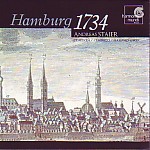 HAMBURG 1734 HAMBURG 1734
Harpsichord works by Telemann, Mattheson, Buxtehude, Handel, B�hm, Weckmann, Scheidemann, & Pauset
This has got to be the most purely ebullient harpsichord recital since Rafael Puyana's Scarlatti program for this same label, issued nearly two decades ago. Andreas Staier plays on a modern copy of a 1734 Heironymus Hass instrument. A noted Hamburg instrument maker, Hass purportedly was inspired by the sound of the organ to create a deluxe harpsichord with two keyboards, a passel of auxiliary stops, and (I have no doubt) wash, rinse, and spin cycles as well. The booklet notes describe the result as "a riot of colors", and they aren't kidding! How you respond to it depends to a large extent on how much you enjoy the sound of big, loud harpsichords in general, but if you're a fan, then you will simply have to feast your ears on this vibrant and brilliantly engineered disc.
The program consists of works that might best be called the "greater Hamburg school", including Handel, Buxtehude, Böhm, Weckmann, Scheidemann, Mattheson, and of course, Telemann. There's also a witty concluding "Entrée" by contemporary composer Brice Pauset, specifically designed to round off the program by letting Staier's instrument strut its gaudy stuff in a more modern harmonic idiom. Highlights include the unbelievably ornate opening Chaconne in G by Handel, followed immediately by the delightful Overture burlesque from Telemann's Der Getreue Music-Meister. Staier also has transcribed two more Telemann overtures, this time for two harpsichords (the very capable Christine Schornsheim assisting): Hamburger Ebb und Fluth, and the Alster-Overtüre. Both of these works are programmatic, and movements such as "Hamburg carillons" and "Concert of frogs and crows" permit ample opportunity to demonstrate the instrument's range of tone colors.
Not all is fun and games, however. Scheidemann's Pavana Lachrymae provides a welcome pause for sadness and some measure of tranquility, while Böhm's Praeludium, Fuga, and Postludium as well as Buxtehude's Praeludium and Fuga in G minor offer examples of the more learned style of the day. It's rather amazing, given the racket that Staier's instrument generates (never mind what happens when two of them get going), that the sonics are so clearly focused and pleasing. At high volume levels such sustained musical virtuosity might become aurally fatiguing, but then, that's your fault. Just turn it down, and keep on listening. You won't hear a more imaginative, better played Baroque keyboard extravaganza anywhere.
--David Hurwitz
|
